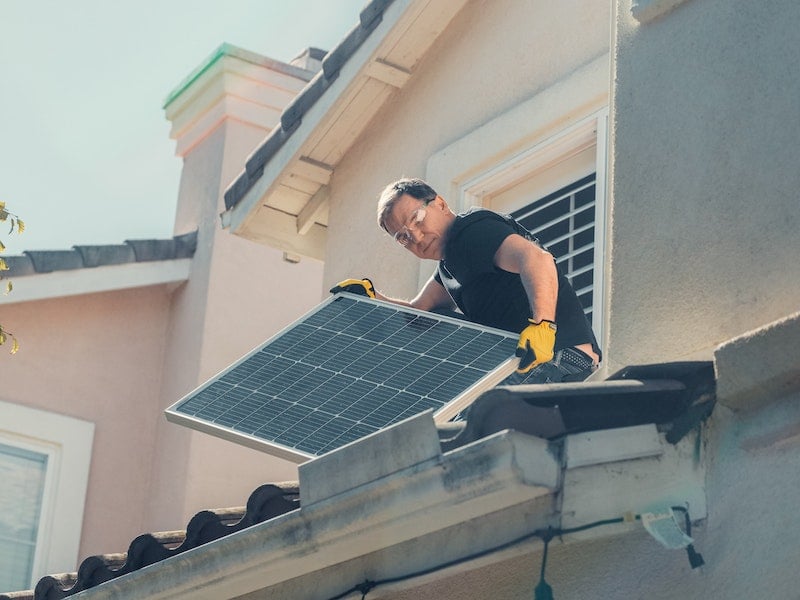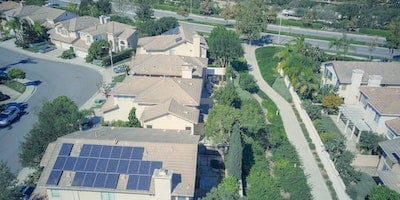
Solar Power Purchase Agreements Explained
Learn how Solar Power Purchase Agreements work.
Is solar right for you?
Find out in less than a minute.
There’s a lot of ways to go solar, and a lot of good reasons why, too. Cleaner energy you control that’s reliable and affordable? Sign me up! But there are more ways to include solar panels on your home than outright buying them or paying a lease over months. While in many cases, solar installations end up paying for themselves well before the end of their 25-year life cycle, there is another option you may want to consider if you’re looking for a no-cost solution.
How Solar Power Purchase Agreements Work
The very simplest way to describe a Purchase Power Agreement (or PPA) is this: a PPA is where you, the homeowner/landowner, agree to allow a developer to place solar panels on your property at little to no cost. Then the homeowner purchases the power generated from the system BACK from the developer at a rate that is lower than what the electric utility company is offering. It’s instant savings without the hassle or upfront costs of owning your own system.
In exchange for your available rooftop or ground space, you will receive a lower energy bill every month, and you have no responsibility for the installation, maintenance, or design of the solar energy system itself.
The lower rate you receive from the developer/owner of the system installed on your property helps to offset your energy costs by reducing the amount you rely on the grid for traditional energy and lowering the cost of the solar energy you are paying for.
Why Developers Offer PPAs
There’s a lot of reasons that PPAs are great for a business or developer. It’s an investment in a cleaner energy future, which can help towards validating corporate sustainability goals, but it also offers them a source of income without the cost of investing in the property itself. When the developer enters into a contract with a homeowner to use the land or rooftop space to install a solar energy system, the hope is to generate more energy than the home needs, and the excess energy generated by the panels can be sold back to the grid for a profit that will eventually cancel out the cost of the installation to turn a profit.
PPAs Have Benefits on Both Sides
A PPA reduces the risk on both sides of the equation, for both you and the developer.
- They do not have to take on the risk of investing wholly in a property, and you don’t have to invest in the upfront costs of a rooftop solar system.
- The developer sees a return from the excess energy sold back to the grid that you’re unable to use.
- You get lower bills due to paying a lower rate for the solar energy generated on your home and due to your reduced reliance on the electric grid.
Approachable Solar
It’s a big step to consider adding solar to your home, and some people are wary to take out such a big loan to make it happen. By using a PPA, you remove the risk of the upfront costs and the hassle of coordinating the install.
When you go solar, you have to find the right installation partner, select the right equipment, go through the permitting and other processes to connect your home to the solar panels and to the grid, and get everything working as it should. With a PPA, the developer will handle all of the processes and you just have to sit back and wait for your bill to come down when your system is activated.
Drawbacks of a PPA
While it is a lower risk way to go solar, it’s also lower reward. When you add solar panels to your home, and you own those panels outright, you can cash in on tax incentives and rebates that help to lower the overall cost of your system. But when you sign a PPA, the owner of the panels receives all of those incentives. The solar investment tax credit (ITC) can save customers 26%
Length of a PPA
How long are you tied to the developer in the case of a purchase power agreement? It depends. It can range anywhere from 10 to 25 years, which is the full length of use for a typical solar energy system. Once your contract ends, it could be possible to extend your PPA. Or, the developer may remove the system, or offer for you to purchase the system for yourself.
Who Maintains the Solar Panels in a PPA?
Throughout the course of the contract, the developer is responsible for the operation and maintenance of the solar energy system.
Other Benefits of PPAs
More than turning on your lights or running your appliances, solar energy can also turn into an opportunity to market your business as a clean energy operation. Solar renewable energy credits (SRECs) are proof of your use of a certain amount of solar energy. SRECs are often traded by energy companies to meet government renewable energy standards, or are used by individuals who voluntarily purchase them for marketing their business as ‘green.’ If this is your goal, be sure to clarify who owns these SRECs in your PPA so you know who is able to sell them.
Your Responsibility in a PPA
Your home is still 100% your responsibility, and when you enter into a PPA, there may be some updates or maintenance needed to ensure a smooth installation. While the developer is responsible for the install, you’re responsible for everything that leads up to it. That can mean repairs to your roof or structure to make sure it can support the solar system, making sure that your electric panel is fully capable to handle the new load, and any other adjustments to your home or property to ensure an install that delivers maximum return. It could even be something as simple as clearing trees or branches from obstructing the sun’s rays.
Owning, leasing, or entering into a PPA for solar are all valid ways to include reliable, clean solar energy in your electricity mix. Solar is affordable, renewable energy we can all use, and a purchase power agreement could be right for your energy needs.
Written by Thad Warren
Thad is a native Texan who has worked in the energy industry for just over 5 years.
Connect
Recent Posts
Compare Texas Solar Buyback Plans
Discover the best Texas solar energy buy back programs for 2025! Compare rates, terms, and providers to maximize savings and make the most of your solar investment.
September 2025

7 minutes

How Efficient Are Solar Panels
How efficient are solar panels compared to other types of energy generation?
March 2023

4 minutes

What You Need To Know About The California Solar Mandate
Learn how the California Solar Mandate changes how new homes are built.
July 2023

4 minutes


